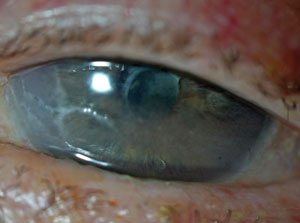 |
Q: A recent 76-year-old patient of mine has developed a rapid recurrence of her band keratopathy following removal by chelation. What’s the likely cause of her rapid accumulation of calcium or phosphorous?
A: Band keratopathy is a common corneal disease characterized by the appearance of a band across the central cornea formed by the deposition of calcium from aqueous tears onto the subepithelial corneal surface. Patients with this condition may complain of reduced visual acuity (as the calcium deposition affects the visual axis), foreign body sensation and irritation.
A chelation is one method of treating band keratopathy; it involves “the scraping of the epithelium, administration of disodium EDTA and multiple cornea scrapings,” says Eric Donnenfeld, MD, who performs refractive and cataract surgery on Long Island.
“The healing can be uncomfortable and visual rehabilitation prolonged. Promoting healing and reducing inflammation is imperative to reduce the risk of recurrent band keratopathy—once the epithelium is intact, the risk of recurrence decreases significantly.”
Some patients are more at risk for recurrence, however, says Rishi K. Parikh, MD, an ophthalmologist in Atlanta. Patients with Paget’s disease, sarcoidosis, hyperparathyroidism or kidney issues are more likely to have excess calcium in their systems, which can present in the tears and lead to deposition on the cornea. Calcium deposition can also occur as a result of low phosphorous levels in patients with renal failure, and as a result of pH changes in patients with uveitis, Dr. Parikh adds.
 | |
| Band keratopathy as a result of calcium deposition. Photo: Aaron Bronner, OD. |
Excess supplementation can also lead to calcium buildup, Dr. Donnenfeld notes, “so make certain the patient is not consuming an inordinate amount of antacids or other causes of milk alkali syndrome.” Band keratopathy has also been linked to the presence of certain levels of drugs and supplements in the body other than calcium, such as excess vitamin D.1 Patients who frequently use eye drops containing phosphate salts, especially phosphate topical steroids, are also more prone to band deposition.2
Two less common factors that may contribute to the development of band keratopathy are silicone oil and mercury, Dr. Parikh says. Silicone oil is used as a retinal tamponade during vitreous surgery for retinal detachments and is typically left in the eye for several months; this practice has been shown to correlate with band keratopathy.3 Patients who have worked with mercury in the past may also be at greater risk for the corneal disease.4 Pilocarpine contains trace levels of mercury, so consider its potential involvement in glaucoma patients on long-term therapy with cholinergic agents.
Regardless of the presentation’s cause, however, when a chelation is required for the second time consider more aggressive healing measures. “I promote healing with an amniotic membrane, use copious corticosteroids and, if the stromal bed is irregular, will perform a lamellar keratectomy to smooth the corneal surface,” Dr. Donnenfeld says. “In most cases, the second time is the charm.”
1. Gifford ES, Maguire EF. Band keratopathy in vitamin D intoxication; report of a case. AMA Arh Opthalmol. 1954 Jul;52(1):106-7.2. Rao GP, O’Brien C, Hicky-Dwyer M, Patterson A. Rapid onset bilateral calcific band keratopathy associated with phosphate-containing steroid eye drops. European Journal of Implant and Refractive Surgery. 1995 Aug;7(4):251-2.
3. Bennett SR, Abrams GW. Band keratopathy from emulsified silicone oil. Arch Opthalmol. 1990 Oct;108(10):1387.
4. Gallin MA, Obstbaum SA. Band keratopathy in mercury exposure. Ann Ophthalmol. 1974 Dec;6(12):1257-61.

